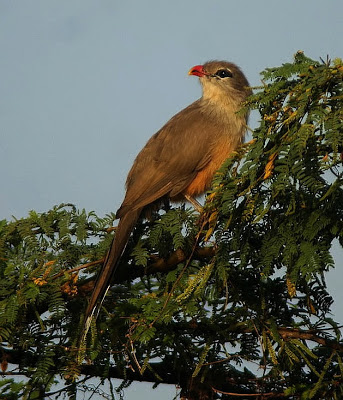Over the last few weeks have been noticing a Sirkeer Malkoha near my house. Think its probably the same bird, because its usually close or around the same spot. This is a largish bird that is mainly brown and rufous in colour, It has a long heavy tail edged with white tipped graduated tail feathers. It is related to the Coucal (which is commonly observed throughout this area). The bill of the Sirkeer Malkoha is hooked and bright cherry-red and yellow. The sexes are the same but juveniles are duller.
 |
| Bird Preening |
The Samudram Eri seems to be the perfect location for this bird because its preference is open scrub and thorn jungle, singly or in pairs. It moves about thickets and undergrowth like the Crow-Pheasant, searching for food such as insects, lizards, fallen fruit and berries. This bird is a feeble flier, and is similar in movement to the Coucal in that it ascends trees rapidly and agilely hops from branch to branch.
 |
| Close up of its Cherry Red and Yellow Beak |
The call of the bird is a subdued "bzuk... bzuk" ; also an alarm call of "p'tang" with a metallic quality. It has a sharp kek-kek-kek-kerek-kerek of the quality of the Rose Ringed Parakeet’s shrieks.
Video of Bird on Roadside
 |
| Adult Bird on Tree |
Its nesting season is from March to August, varying with locallity. It is non parasitic. Its nest is usually a shallow saucer of twigs lined with leaves in a thorn bush or sapling about 2-7 metres up. It lays from 2-3 white eggs.
 | |
| Bird on Ground |







